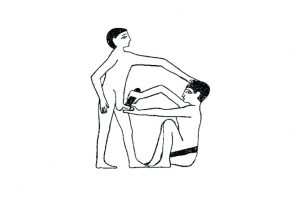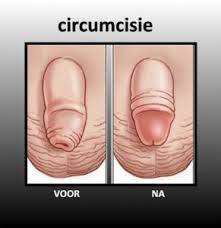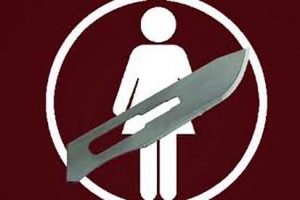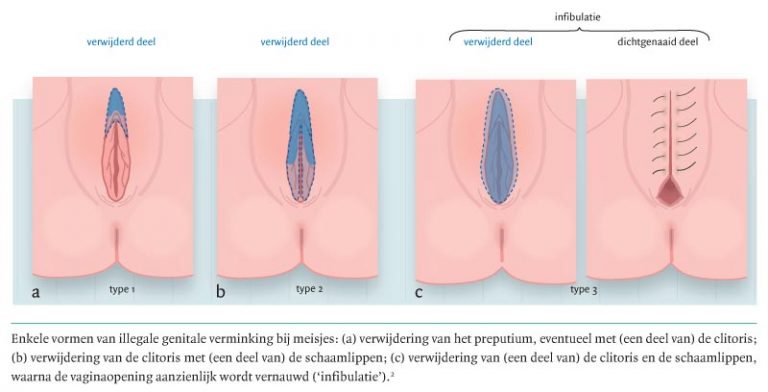circumcision
 Circumcision means ‘cutting around’. In boys, the front part of the (round) foreskin is cut off, so that the head of the penis is permanently uncovered. In girls, a similar incision can be made in the foreskin of the clitoris.
Circumcision means ‘cutting around’. In boys, the front part of the (round) foreskin is cut off, so that the head of the penis is permanently uncovered. In girls, a similar incision can be made in the foreskin of the clitoris.
In addition to this relatively light and symbolic operation, there are more crippling forms of mutiilation of girls’ genitals. Removing part of the foreskin is sometimes prescribed for boys or men who suffer from phimosis. Another medical operation on the male genital is cutting the frenulum, when that is felt to be too short. The frenulum should allow he foreskin to move back all the way behind the head of the penis.
Medical circumcision

before & after
Medical circumcision is still practised widely on boys. In many American states, male babies and infants are routinely circumcised for hygienic reasons. For a long time protests have been made against this practice, which, strictly speaking, is a form of sexual mutilation, and must be seen as an unnecessary interference with the integrity of the human body, or as a form of sexual child abuse. Circumcision is also defended as an effective measure to prevent cervical cancer in women. Also, circumcised men are thought to be better protected against sexually transmitted infections (sti), because the skin of the glans, being hardened by constant exposure, is thought to be more resistant to viruses. As is usual in such controversy, evidence is hard to come by and seldom fully reliable.
Medical circumcision of girls never became a routine, but was for some time in the 19th and 20th centuries an accepted gynaecological operation to combat nymphomania, even in young girls.
Religious circumcision
Jewish and islamic children are circumcised as part of their religious enculturation, which is of ourse also a pedagogic event with a strong socio-psychological effect. Ages vary, but the circumcision mostly takes place before puberty, between eight days after birth and 9 years. Circumcision is a public occasion like birth, baptism, and marriage, in which family and relatives celebrate solemnly a primary life event which incorporates the indivual into the sexual system. Such events have a deep impact on the inividual’s psychology and behaviour. They are very emotional, mixing pain and joy, underpin the self-evident power structure of the family, demand obedience to tradition and outward conformity to sexual standards and values, and create lifelong memories that tie the individual to partner, family, relatives, culture and nation. The disadvantages of this limited loyalty are those typical of the sexual system as a whole.
Circumcision of girls
The circumcision of girls is given much more attention than the circumcision of boys, and is far more severely criticized. In the dominant opinion of the modern world, male circumcision is generally accepted or ignored, while female circumcision has become a horror term, described as a form of mutilation, and linked to sexual discrimination, injustice, the suppression of women in society, and associated with ignorance, poverty and superstition. True as this is, female circumcision must be understood as an extreme measure, supported and carried out by the women of the tribe, to safeguard girls from becoming sexually active before they are married. This principle of guiding and guarding girls to the altar is, however, also a corner stone of modern sexual morality, so female circumcision also reflects on the underlying beliefs of the critics. In other words, indignation about female circumcision could be the pot calling the kettle black. In practice, female circumcision may be no more than an incision into the foreskin of the clitoris, painful and frightening, as it is for boys, but afterwards celebrated and rewarded. Accidents may happen which cause damage to the clitoris (just as a penis may become disfigured by a botched operation).
The most extensive form of female circumcision involves the complete removal of the visible clitoris and parts of the inner labia and the sewing up of the outer labia, leaving only room for the urine exit and a small opening for passing menstrual blood. The girl is supposed to marry young, and be opened up or ‘deflowered’ by her husband, a very painful and sometimes impossible task.
 Circumcision and sexual pleasure
Circumcision and sexual pleasure
Circumcision does not eradicate sexual pleasure. Men and women still get sexually aroused’, masturbate and have orgasms. However, lust is obviously even more under pressure and relegated to private life than is the case in more modern parts of the world. In circumcised women, more even than in men, lust becomes associated with pain and suffering, of which child bearing is the natural and logical consequence. This process may be said to be pre-programmed genetically and socially, because it goes back to time immemorial, and is also still very much in evidence among the majority of more modern females.
Circumcision and the sexual system
Thus there is a common factor in male and female circumcision. Both are initiated into the sexual system, which means that they are expressly and publicly categorized as male or female. The ‘female’ aspect of males, i.e. the foreskin, and the ‘male’ aspect of females, the clitoris, are cut away. This emphasizes the distinctness and separation of the sexes, removing as it were any common or mixed features. The distinction between the sexes is a condition for reproduction. Thus circumcision is a manifestation of the logical link between gender distinction, sexual suffering, pregnancy, marriage and the family. In the modern world these aspects of the sexual system have become less harshly enforced, but under a surface of affluence and liberty still form the basis of the social structure.
